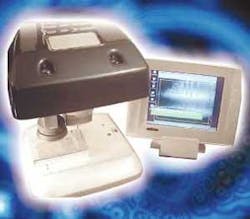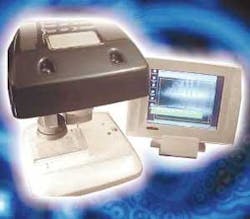Part-marking verifies products
By permanently marking a product in the initial stages of manufacture, parts can be tracked through a manufacturing process and end of useful life. For parts that are critical for safety and have high value, permanent direct part marking can significantly reduce the value of scrap and rework, deter counterfeiting, reduce bogus warranty claims, and, in the event of a part failure, aid failure analysis and identify other parts that may be susceptible to the same type of failure.
Traditionally, parts have been marked with human-readable marks and serial numbers. Machine-readable data-matrix codes now allow parts to be permanently marked with large amounts of data. In automotive and aerospace applications, this allows critical parts to be marked and then scanned anywhere in the world against the manufacturer's database.
The marking technology depends upon the nature of the part to be marked, the material, and the type of mark required. Although simple indent methods such as hand stamps, type, and engraved dies are still widely used, programmable technologies that include precision controlled dot-peen equipment are becoming popular. In this method, a carbide-tipped stylus is used to indent marks as a series of discrete dots.
To read and verify such codes, a number of vendors produce either hand-held or computer-based two-dimensional data-matrix readers. When integrated with dot-peen marking machines, these systems form complete marking, reading, and product verification systems.
At the VISION 2003 show (Stuttgart, Germany), a number of companies including RVSI (Nashua, NH, USA; www.rvsi.com) and Vision Components (Ettlingen, Germany; www.vision-comp.com) showed combined data-matrix/marker and inspection systems from third-party vendors. These systems, from Muko Maschinenbau (Waiblingen, Germany) and AIT Gohner (Stuttgart, Germany), respectively, combined dot-peen marking machines and a smart camera as the basis for vision inspection of the data-matrix code (see Vision Systems Design, December 2003, p. 25).
This trend continued at the February IPOT show (Birmingham, UK), with Edward Pryor and Son (Pryor; Sheffield, UK; www.pryormarking.com), an industrial marking-equipment supplier, acquiring Absolute Vision (Meriden, UK: www.absolutevision.co.uk), a developer of 2-D code-reading and machine vision systems. According to Charlie Plain-Jones, Absolute Vision European sales manager, the two companies will continue trading as separate entities but will draw on each other's technical experience.
At the show, Absolute Vision displayed Pryor's dot-peen machine with a positional accuracy of 0.025 mm, capable of marking 20 × 3-mm characters in 2.2 s. These £3000–£4000 ($5500–$7300) PC-based machines use electric—as opposed to pneumatic—actuators to punch data-matrix code on automotive and aerospace products. To perform dot-matrix code reading, one of Pryor's dot-peen machines was demonstrated with the Medusa 2-D data-matrix-code reader from Absolute Vision.
Interfaced over an RS-232 link to the PC-based marker, the Medusa code-reading software supports many different types of 1- and 2-D codes and a range of error-correction systems, including ECC200. According to Plain-Jones, ECC200, the latest version of data-matrix error-correction algorithm, supports advanced encoding and error checking with Reed Solomon error-correction algorithms and allows the recognition of barcodes that are up to 24% damaged.
The Medusa code reader allows systems integrators to use preconfigured image setups that include data-matrix code that is dot-peened on metal, dot-peened on plastic, laser-etched on metal, and laser-etched on glass. With a cost of £6000 ($11,000), the combined dot-peening/data-matrix-reading machine is cost-competitive with those from other vendors.
After data-matrix marking and reading, another Medusa smart sensor can add dot-matrix verification to the machine. This sensor reads the data matrix and measures the size, spacing, and morphology of the dots before a part is shipped. According to Plain-Jones, this would add another £1500 ($2700) to the cost of the machine.

